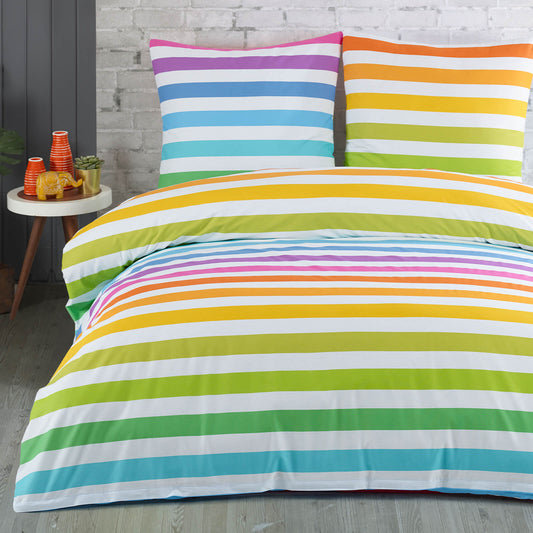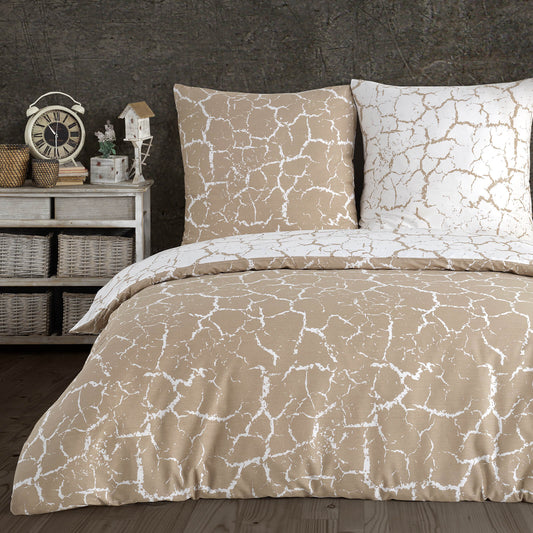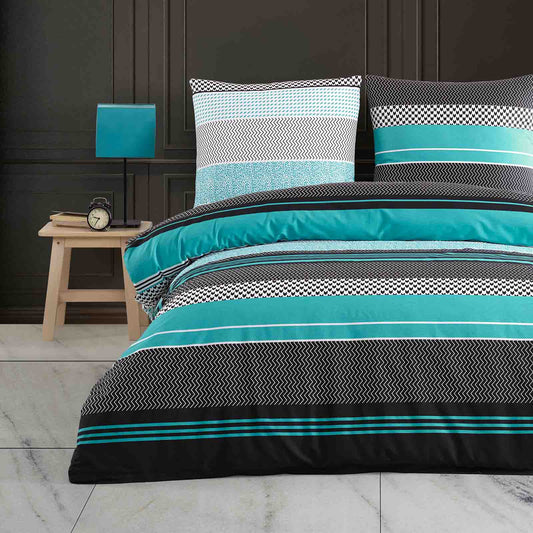Find and buy the perfect fitted sheet
What are fitted sheets?
Fitted sheets are special sheets used to cover and protect the mattress of a bed. They have elasticated edges or corners that allow the sheet to be stretched tightly and securely over the mattress. This keeps the sheet smooth while you sleep and does not slip easily. Fitted sheets come in different materials, such as cotton, jersey or microfiber, and in many sizes to cover different mattress types and sizes.

How are fitted sheets made?
Fitted sheets are made from different materials such as cotton, polyester, jersey or flannel. The production of fitted sheets consists of several steps:
-
Choosing the material: First, choose the material the fitted sheet is to be made of. Most fitted sheets are made of cotton or a blend, but there are also versions made of other materials such as jersey or flannel.
-
Cutting the fabric: The fabric is cut to the desired size, keeping in mind that the size of the sheet is slightly larger than the mattress size to ensure a good fit on the mattress. Most of the time, the corners of the fabric are rounded to achieve a better fit.
-
Sewing the corners: To make the fabric fit the mattress better at the corners, seams are sewn at the corners. To do this, the rounded corners of the fabric are placed on top of each other and sewn together. This creates a kind of pocket that can be pulled over the corners of the mattress.
-
Attaching the elastic band: An elastic band is used to fix the fitted sheet to the mattress. This is either sewn completely around the edge of the sheet or only attached to the corners. The elastic band ensures that the fitted sheet sits tightly on the mattress and does not slip.
-
Finishing and packaging: After the fitted sheet has been sewn and the elastic band has been attached, it can still be finished. This includes, for example, ironing or applying a logo. The finished fitted sheet is then packaged and is ready for sale.
The manufacturing of fitted sheets can vary depending on the material, size and finish, but essentially most manufacturers follow these basic steps.
How should fitted sheets be cared for?
Caring for fitted sheets is important to prolong their life and ensure good hygiene. Follow these steps to properly care for your fitted sheets:
-
Washing: Wash fitted sheets regularly, about every one to two weeks, or more often if necessary. Read the care label to find out the recommended washing temperature and type of detergent. Typically, fitted sheets can be washed at 40-60 degrees Celsius. Use a mild detergent and avoid bleach or optical brighteners to preserve the colors and material.
-
Drying: Fitted sheets can be either air dried or tumble dried. When air drying, the sheet should be hung evenly to avoid wrinkling and allow for faster drying. If using a tumble dryer, select a low heat setting to protect the material and prevent shrinkage. Remove the sheet once it is dry to avoid wrinkling.
-
Ironing: Iron fitted sheets when necessary, paying attention to the recommended ironing temperature on the care label. To remove wrinkles, iron the sheet when it is still slightly damp. Fitted sheets made of materials such as jersey or terry cloth usually do not need to be ironed.
-
Storage: Fold fitted sheets neatly and store in a cool, dry place to prevent mold and discoloration. Avoid direct sunlight to prevent colors from fading.
-
Stain removal: Remove stains as soon as possible following the care label instructions. Use stain removers only if the label allows it and test on an inconspicuous area of the sheet first to avoid possible discoloration.
Follow these care tips to extend the life of your fitted sheets and ensure good hygiene.
What sizes are available for fitted sheets?
Fitted sheets come in different sizes to suit different mattress sizes. The most common sizes are:
-
Single bed sheet:
-
90 x 200 cm
-
100 x 200 cm
-
Double bed sheet:
-
140 x 200 cm
-
160 x 200 cm
-
180 x 200 cm
-
200 x 200 cm
-
Special sizes:
-
80 x 200 cm (narrow single bed)
-
120 x 200 cm (intermediate size)
-
220 x 240 cm (oversize)
Please note that sizing may vary depending on the brand and country of manufacture. It is important to know the exact dimensions of your mattress in order to choose the right fitted sheet.
What materials are used for fitted sheets?
Fitted sheets are made from different materials to suit different needs and preferences. Some of the most common materials are:
-
Cotton: Cotton is the most commonly used material for fitted sheets. It is soft, breathable and durable, making it ideal for everyday use. Cotton sheets come in different qualities, such as Egyptian cotton or Pima cotton, each offering greater comfort and softness.
-
Polyester: Polyester is a synthetic material that is often used in combination with cotton to make sheets that are less prone to wrinkles and easier to care for. Polyester-cotton blends are durable, inexpensive, and available in many colors and patterns.
-
Jersey: Jersey is a knitted material that is often made of cotton, viscose or blended fabrics. Jersey fitted sheets are soft, elastic and fit well to the mattress. They are particularly cozy and are ideal for colder nights.
-
Flannel: Flannel is a soft, brushed fabric that is usually made of cotton or a cotton blend. Flannel sheets are warm, cozy, and ideal for use during the colder months.
-
Satin: Satin is a smooth, shiny material that can be made from silk, polyester, or a blend of these materials. Satin sheets have a luxurious look and feel and are ideal for those who prefer a smooth and cool feel.
-
Microfiber: Microfiber is a synthetic material made of fine fibers that offers a soft, silky feel. Microfiber sheets are easy to care for, durable, and hypoallergenic, making them ideal for people with allergies or sensitive skin.
What is the best way to iron fitted sheets?
To best iron fitted sheets, follow these steps:
-
Wash and dry the fitted sheet according to the instructions on the care label.
-
Set the iron to the appropriate temperature for the fabric of the fitted sheet. Check the care label to find out what temperature is recommended.
-
Place the fitted sheet on the ironing board with the inside facing up, so that one of the corners is on the narrow side of the ironing board.
-
Pull the elastic edge of the fitted sheet tight so that the fabric lies flat on the ironing board.
-
Start ironing the corner and work your way along the elastic edge. Make sure to move the iron evenly across the fabric, avoiding the elastic edge. Iron only the fabric, not the elastic edge.
-
Rotate the fitted sheet as needed to iron all four corners and the entire surface of the sheet.
-
When you're done, fold the fitted sheet neatly by first tucking the corners together and then folding the sheet to the desired size.
Tip: To minimize wrinkles, iron the fitted sheet while it is still slightly damp. This will allow the iron to glide more easily over the fabric and leave a smoother finish.
What should you pay attention to when buying fitted sheets?
When buying fitted sheets, you should pay attention to the following criteria:
-
Material: Fitted sheets are available in various materials. The most common materials are cotton, jersey, Mako satin, microfiber or flannel. Make sure that the material is skin-friendly, breathable and easy to care for. Cotton and jersey are particularly recommended as they offer a high level of sleeping comfort and absorb moisture well.
-
Size and fit: The size of the fitted sheet should be exactly matched to the dimensions of your mattress. Make sure that the sheet is also suitable for the height of your mattress, especially if you have a thick mattress or a mattress topper. Most fitted sheets are elastic and adapt well to the mattress.
-
Quality: Pay attention to the quality of the fitted sheet. A higher price is often an indicator of better quality, but not always. Pay attention to the workmanship, the weave and the thread count of the fabric. High-quality fitted sheets are more durable and offer greater sleeping comfort.
-
Care Instructions: Check the fitted sheet's care instructions to make sure it's easy to clean and maintain. Most fitted sheets are machine washable and tumble dryable, but it's always good to check before purchasing.
-
Colors and patterns: Fitted sheets are available in many different colors and patterns. Choose a color or pattern that matches your bedding and the style of your bedroom.
-
Allergy-friendly: If you have allergies, make sure the fitted sheet is hypoallergenic and suitable for allergy sufferers. Some materials, such as microfiber, are particularly good for allergy sufferers as they attract less dust and mites.
-
Price: Set a budget for buying fitted sheets and compare the prices of different suppliers and brands. However, it is advisable to pay attention not only to the price but also to the quality and the criteria mentioned above.
-
Manufacturer and warranty: Buy fitted sheets from a reputable manufacturer known for the quality of its products. Also pay attention to the warranty conditions in case there are any problems with the product.
What are the advantages of fitted sheets?
Fitted sheets offer several advantages over conventional sheets:
-
Easy to use: Fitted sheets are easy to put on because they have elastic corners or edges. This allows for quick and easy attachment to the mattress.
-
Wrinkle-free surface: Due to their design, fitted sheets adapt perfectly to the mattress and remain wrinkle-free. This ensures a comfortable lying experience and a neat appearance.
-
Non-slip: Fitted sheets stay on the mattress better than regular sheets because they are elastic at the corners or edges. This means they don't slip as easily while you sleep and provide a more stable sleeping surface.
-
Hygiene: Because fitted sheets fit tightly to the mattress, they offer protection from dust, dirt and allergens. They can also be easily removed and washed, which increases hygiene in bed.
-
A variety of sizes and materials: Fitted sheets are available in different sizes and materials, such as cotton, jersey, terry cloth or microfiber. This means that the right sheet is available for every taste and need.
-
Longer durability: Because fitted sheets slip less and have a stronger hold on the mattress, they are subject to less wear and tear and therefore usually last longer than conventional sheets.
- Aesthetics: Fitted sheets look more attractive than conventional sheets due to their wrinkle-free surface and precise shape, thus contributing to an attractive look in the bedroom.
Kunden kauften auch
-
Renforcé bed linen "Rainbow", 100% cotton, zipper, 80x80 cm pillowcase
Regular price From €29,90 EURRegular priceUnit price / per -
Renforcé bed linen "Mercer Beige", 100% cotton
Regular price From €29,90 EURRegular priceUnit price / per€39,90 EURSale price From €29,90 EURSale -
Renforcé bed linen "Almira", 100% cotton, zipper, floral, 80x80 pillowcase
Regular price From €29,90 EURRegular priceUnit price / per -
Renforcé bed linen "Zigo Turquoise", 100% cotton, zipper, 80x80 cm pillowcase
Regular price From €29,90 EURRegular priceUnit price / per




